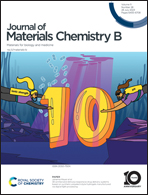Quercetin@Gd3+ doped Prussian blue nanocubes induce the pyroptotic death of MDA-MB-231 cells: combinational targeted multimodal therapy, dual modal MRI, intuitive modelling of r1–r2 relaxivities†
Abstract
Quercetin (Qu), a potential bioflavonoid has gained considerable interest as a promising chemotherapeutic drug which can inhibit the proliferation of triple-negative breast cancer (TNBC) cells due to its regulation of the expression of tumor-suppressor gene metastasis and antioxidant property. Notably, Qu exhibits a very negligible cytotoxic effect on normal cells, even with high-dose treatment, while it is shows high affinity to TNBC. However, the efficiency of Qu is limited clinically due to its poor bioavailability, caused by its low aqueous solubility (2.15 μg mL−1 at 25 °C), rapid gastrointestinal digestion and chemical instability in alkaline and neutral media. Herein, polydopamine (PDA)-coated, NH2–PEG–NH2 and hyaluronic acid (HA)-functionalized Gd3+-doped Prussian blue nanocubes (GPBNC) are reported as a multifunctional platform for the codelivery of Qu as a chemotherapeutic agent and GPBNC as a photodynamic (PDT) and photothermal (PTT) agent with improved therapeutic efficiency to overcome theses barriers. PDA, NH2–PEG–NH2 and HA stabilize GPBNC@Qu and facilitate bioavailability and active-targeting, while absorption of near infrared (NIR) (808 nm; 1 W cm−2) induces PDT and PTT activities and dual T1–T2-weighted magnetic resonance imaging (MRI) with high relaxometric parameters (r1 10.06 mM−1 s−1 and r2 24.96 mM−1 s−1 at a magnetic field of 3 T). The designed platform shows a pH-responsive Qu release profile and NIR-induced therapeutic efficiency of ∼79% in 20 minutes of irradiation, wherein N-terminal gardermin D (N-GSDMD) and a P2X7-receptor-mediated pyroptosis pathway induces cell death, corroborating the up-regulation of NLRP3, caspase-1, caspase-5, N-GSDMD, IL-1β, cleaved Pannexin-1 and P2X7 proteins. More interestingly, the increasing relaxivity values of Prussian blue nanocubes with Gd3+ doping have been explained on the basis of Solomon–Bloembergen–Morgan theory, considering inner- and outer-sphere relaxivity, wherein crystal defects, coordinated water molecules, tumbling rate, metal to water proton distance, correlation time, magnetisation value etc. play a significant role. In summary, our study suggests that GPBNC could be a beneficial nanocarrier for theranostic purposes against TNBC, while our conceptual study clearly demonstrates the role of various factors in increasing relaxometric parameters.



 Please wait while we load your content...
Please wait while we load your content...